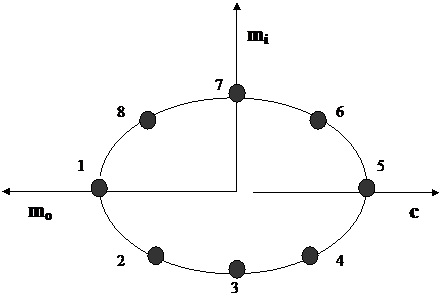General:
All axes are right handed. Directions for environments are the
direction from which the environment comes.
The body system is used for simulations. In most cases, the body
system will be identical to the part system of the part which has the
same name as the body. The axes of the body system are parallel to the
global system when roll, yaw, and pitch are zero. The orientation of
the body system defines the orientation of the body by three Euler
angles, yaw, followed by a pitch, followed by a roll. An illustration
of the global and part coordinate system along with a jacket
and vessel body system during a launch is shown below.
Vessel Motion :
In the frequency domain, the motions are reported in
the body system.
The Surge motion is along the X, positive aft, Sway is
along the Y axis,positive Starboard, and Heave is along the
Z axis, positive Up. Roll is a rotation about X positive
from Y toward Z (i.e. positive Roll is Starboard up).
Pitch is a rotation about Y positive from Z to X
(i.e. positive Pitch is Stern down).
Yaw is a rotation about Z positive from X to Y
(i.e. positive is Bow to Port or Stern to Starboard).
Motion Phases:
RAO phases are relative to the wave elevation at the point being reported.
Clearly the phase relative to a point on the body depends upon
the location of the vessel origin. Normally its location is that
shown above. In any event, there is an additional phase shift
due to spatial separation of the point of interest and the origin.
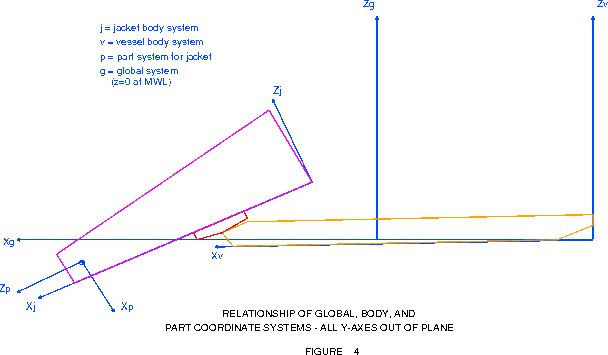
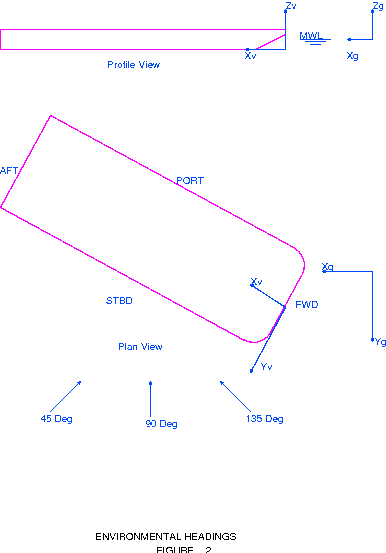
The Wave Elevation, eta, is given by
eta = a*cos(w*t + k*x*cos(beta) + k*y*sin(beta))where a is the wave amplitude, w the encounter frequency, k is the wave number, x and y are the global coordinates of the point of interest, and beta is the wave heading angle and shown above. The heading is the angle from which the sea comes, measured relative to the X axis; i.e. beta equal 180 corresponds to a head sea, beta equal 90 corresponds to a sea striking the Starboard beam.
The resulting Vessel Response is then given by
r = R*cos(w*t + phi) RAO = R/awhere phi is the phase.
Structural Elements:
If the -REFN option is specified, then the beam Y axis is defined as the vector cross product of the vector from the beginning of the beam to *REFNOD with the beam local X axis. The beam Z axis is then given by the cross product of the beam X axis with the beam Y axis.
If -REFN is not specified, then the local axes are defined based on the -STGAXIS option of a &MODEL_DEF command. This defines two vectors: SAV1 and SAV2 which define local Y and Z as follows:
- If the beam X axis is not parallel to the SAV1 vector, then the beam Y axis will be defined by the cross product of the SAV1 vector and the beam X axis.
- If the beam X axis is parallel to the SAV1 vector, then the beam Y axis is determined by the cross product of the SAV2 vector with the local X axis.
After the local system has been defined, it can be rotated about
the local X axis with the -CA option. Here, CHANG is the beam
chord angle (degrees). The rotation of the system is about the beam
x axis, positive towards the beam negative Y axis (right hand rule).
The relationship of the local coordinate
system is shown;
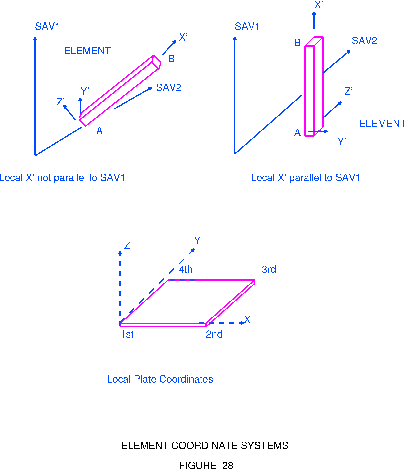
Joint coordinate system:
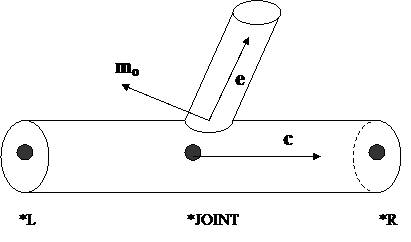
Let
e be a unit vector along the brace X axis acting from the joint toward the other end of the brace and
c be a unit vector from the chord "left joint" to the joint
then e is the force direction and the directions for inplane (mi) and out of plane bending (mo) are given by:
mi = (exc)
/ ||exc||mo = (exmi)
/ ||exmi||
